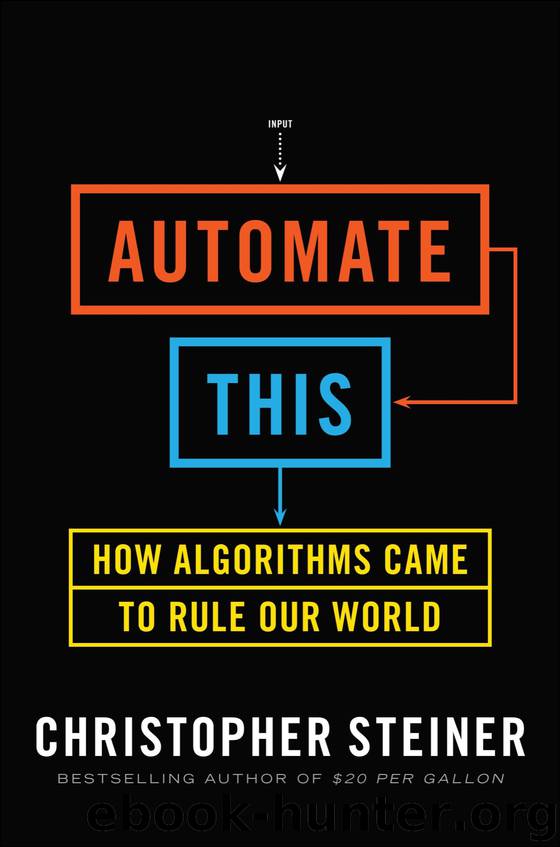Automate This by Christopher Steiner

Author:Christopher Steiner
Language: eng, eng
Format: epub
Publisher: Penguin Group, USA
Published: 2012-07-31T16:00:00+00:00
TO BUILD CUNNING WITH CODE
Sandholm is an expert in game theory, the field of math concerning complex problems that include unknown variables and multiple parties with differing interests. Game theory has allowed Sandholm to build poker algorithms that make decisions with only partial solutions to their problem. “When you start trying to account for every single variable in poker, you get into trouble,” he says.
In chess, every variable is known to all; in poker, the player only knows his own cards and the cards, if any, that are facing up on the table. Other than that, the player must rely on his own gut, his knowledge of his opponents’ tendencies, and his ability to read other players’ faces and hands for signs that they’re bluffing or holding a good hand. Poker bots can’t read faces, at least not yet, so to be effective against good players they must learn how to bluff, how to call others’ bluffs, and when to fold in the face of what’s likely a big hand for an opponent.
Sandholm, who speaks with the slightest of accents, was born and raised in Finland and looks the part of Nordic conqueror with his sandy hair, high cheekbones, and cleft chin. In 1990 he built his first commercial algorithm, an automated negotiation platform for ride sharing. Riders could introduce routes for which they sought rides, and drivers could answer with price quotes. Each rider introduced a different route variation to each driver, making for a complex market that could only be tamed by the perfect algorithm. Sandholm’s foray into carpooling ultimately failed as the market didn’t behave how his bot had expected. It turned out that some humans were perfectly happy to make a few bucks to drive others; others, however, demanded far higher—and thus, to the algorithm, irrational—premiums for the disturbance of their solo commute.
As he gained experience in complex transactions, Sandholm became better at modeling humans and their varying methods of decision making. He wrote game theory algorithms that negotiated markets with thousands or even millions of variables. For instance, when a company such as General Mills seeks to hedge its exposure to spikes in the price of grain, there are thousands of ways to do it, from buying call options to placing blind and bullish bets on commodities in New York and Chicago. Thousands of factors affect the decision, from weather patterns in North America and Asia to the direction of the stock market, the prevailing interest rates, and the threat of an insect pest or drought affecting the crop. Making the right bet at the right time—and for all the right reasons—can save General Mills millions of dollars. But many of the variables required to make the best decision are unknown. Some can be predicted quantitatively, although not definitively, such as the weather. Other variables, like how traders will react to certain events and how other large grain buyers will hedge their own positions, depend on how those players view their best interest. That self-interest is exactly what game theory helps predict.
Download
This site does not store any files on its server. We only index and link to content provided by other sites. Please contact the content providers to delete copyright contents if any and email us, we'll remove relevant links or contents immediately.
| AI & Machine Learning | Bioinformatics |
| Computer Simulation | Cybernetics |
| Human-Computer Interaction | Information Theory |
| Robotics | Systems Analysis & Design |
Algorithms of the Intelligent Web by Haralambos Marmanis;Dmitry Babenko(16234)
Jquery UI in Action : Master the concepts Of Jquery UI: A Step By Step Approach by ANMOL GOYAL(9386)
Test-Driven Development with Java by Alan Mellor(7735)
Data Augmentation with Python by Duc Haba(7608)
Principles of Data Fabric by Sonia Mezzetta(7378)
Learn Blender Simulations the Right Way by Stephen Pearson(7294)
Microservices with Spring Boot 3 and Spring Cloud by Magnus Larsson(7137)
Hadoop in Practice by Alex Holmes(6587)
RPA Solution Architect's Handbook by Sachin Sahgal(6515)
The Infinite Retina by Robert Scoble Irena Cronin(6216)
Big Data Analysis with Python by Ivan Marin(5933)
Life 3.0: Being Human in the Age of Artificial Intelligence by Tegmark Max(5513)
Pretrain Vision and Large Language Models in Python by Emily Webber(4894)
Infrastructure as Code for Beginners by Russ McKendrick(4653)
Functional Programming in JavaScript by Mantyla Dan(4436)
WordPress Plugin Development Cookbook by Yannick Lefebvre(4382)
The Age of Surveillance Capitalism by Shoshana Zuboff(4243)
Embracing Microservices Design by Ovais Mehboob Ahmed Khan Nabil Siddiqui and Timothy Oleson(4146)
Applied Machine Learning for Healthcare and Life Sciences Using AWS by Ujjwal Ratan(4135)
